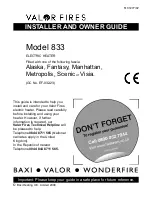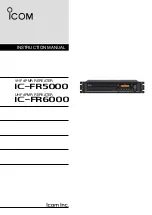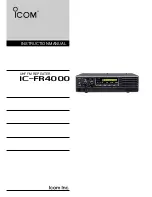
7
from the outside. Apply mastic to the rear face of the Terminal plate and fix to
the wall using screws and wall plugs. Make sure the plate is fixed the correct
way up. (See Figure 3) Slide the flue further into the wall until the tabs on the
wall plate line up with the holes in the outer flue tube. Temporally fix the tube
to the wall plate with the self tapping screws provided. Use the inner holes as
shown in Figure 4.
3
On the inside wall centre and level the convector box over the protruding flue
pipe. Once level, fix the convector box to the wall with four screws and wall
plugs. The convector box has been designed to ensure an air gap remains
between the wall and the back of the convector box. Consideration should be
given to ensure this gap is achieved and not affected by uneven wall surfaces.
4
From the inside of the convector box measure inwards along the flue 6mm. At
this point draw a line completely around the outer pipe. Unscrew the self
tapping screws securing the outer flue tube to the wall plate and withdraw the
flue assembly. Move the polystyrene support ring inside the flue assembly to a
position near the marked line. Cut the excess flue of at the marked line. De-bur
the cut edges and remove the polystyrene ring.
5
Slide the remaining piece of flue, which should include the terminal, on to the
flue connection on the back of the heat exchanger. Note that the two flue tubes
are not concentric and that the inner tube is positioned towards the top of the
outer tube. Using a 3.5mm diameter drill, drill holes through the holes in the
flue outer ring and into the outer flue tube. Secure in place with self tapping
screws and then cover and seal the joint with the length of aluminium tape
supplied. Thread the fibreglass rope ring sealing gasket on to the flue.
6
The gas supply should be routed from the meter or cylinder to a point
underneath or behind the appliance. There are two grommeted apertures
provided for gas pipe entry in the convector box. From this point route the
supply in 8mm diameter tubing to the combined pressure test point and isolator
fitting. Any exposed pipe within the wall cavity should be wrapped, painted with
bituminous paint or factory sheathed. Prior to connecting the burner to the gas
supply it is advisable to blow out the pipe to clear any dirt that may be present
and which could cause a blockage in the control valve or pilot.
7
Lift the heat exchanger and flue assembly and slide the flue assembly through
the hole in the wall until the heat exchanger flange meets the convector box
flange. Fix the heat exchanger to the convector box using the M5 nuts and bolts
supplied. Replace the self tapping screws that secured the flue to the wall plate.
Seal the flue to the wall plate with mastic. Fit the terminal guard centrally over
the terminal using screws and wall plugs.
Figure 4



































